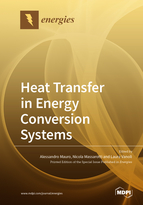Heat Transfer in Energy Conversion Systems
A special issue of Energies (ISSN 1996-1073). This special issue belongs to the section "I: Energy Fundamentals and Conversion".
Deadline for manuscript submissions: closed (31 October 2020) | Viewed by 31634
Special Issue Editors
Interests: energy systems; energy efficiency; geothermal energy; numerical modeling; heat transfer
Special Issues, Collections and Topics in MDPI journals
Interests: heat and mass transport in porous media and free fluids; finite elements; innovative energy conversion systems; renewable energy sources; geothermal energy; fuel cells; heat and mass transfer in biomedical applications; waste to energy systems
Special Issues, Collections and Topics in MDPI journals
Interests: thermodynamic and thermo-economic analysis of advanced energy systems; energy saving; renewable energy sources; dynamic modeling of energy conversion systems; innovative energy conversion systems; energy planning; thermo-fluid-dynamic measurements
Special Issue Information
Dear Colleagues,
The purpose of This Special Issue is to collect interesting and original studies demonstrating the importance of properly taking into account heat transfer phenomena in modern energy conversion systems, in order to improve the conversion efficiency, design and operation techniques of these systems.
Given the importance of verification and validation issues for numerical codes, contributions dealing with both numerical approaches and combined numerical-experimental approaches are appreciated and invited in the Special Issue.
Papers that analyze aspects related to heat transfer, useful for increasing the knowledge of energy conversion systems, on the basis of one or more of the following topics are also welcome:
- Energy sources and energy conversion systems
- Thermodynamic and thermo-economic analysis of energy systems
- Technologies for renewable energy sources
- Heating and air conditioning systems
- Solar thermal and photovoltaic
- Cogeneration
- Energy saving
- Geothermal energy-based systems
- Waste to energy systems
- Fuel cells
- Heat exchangers/heat pipes
- Heat transfer in porous media
- Heat transfer in indoor environments
- Internal flow and heat transfer
- Multi-phase flows.
Please note that the above list is not exhaustive. Therefore, works focused on other research areas that are relevant for this Special Issue are also appreciated.
This special issue is cooperated with ThermaComp 2020 (http://www.thermacomp.com) which will be held in Budva, Montenegro, June 3-5, 2020. Papers from the conference are welcome.
Prof. Dr. Alessandro Mauro
Prof. Dr. Nicola Massarotti
Prof. Dr. Laura Vanoli
Guest Editors
Manuscript Submission Information
Manuscripts should be submitted online at www.mdpi.com by registering and logging in to this website. Once you are registered, click here to go to the submission form. Manuscripts can be submitted until the deadline. All submissions that pass pre-check are peer-reviewed. Accepted papers will be published continuously in the journal (as soon as accepted) and will be listed together on the special issue website. Research articles, review articles as well as short communications are invited. For planned papers, a title and short abstract (about 100 words) can be sent to the Editorial Office for announcement on this website.
Submitted manuscripts should not have been published previously, nor be under consideration for publication elsewhere (except conference proceedings papers). All manuscripts are thoroughly refereed through a single-blind peer-review process. A guide for authors and other relevant information for submission of manuscripts is available on the Instructions for Authors page. Energies is an international peer-reviewed open access semimonthly journal published by MDPI.
Please visit the Instructions for Authors page before submitting a manuscript. The Article Processing Charge (APC) for publication in this open access journal is 2600 CHF (Swiss Francs). Submitted papers should be well formatted and use good English. Authors may use MDPI's English editing service prior to publication or during author revisions.
Keywords
- Energy systems
- Energy conversion
- Energy saving
- Thermo-economic analysis
- Geothermal energy
- Cogeneration
- Waste to energy
- Conduction
- Convection
- Radiation
- Thermo fluid dynamics
- Porous media
- Numerical
- Experimental
- Validation
- Verification







